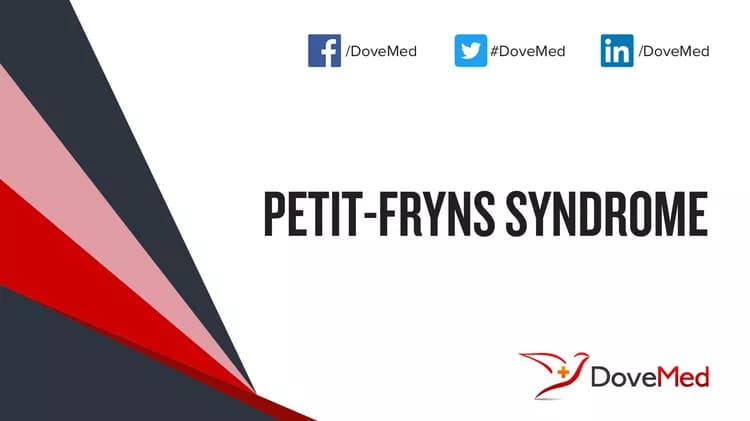What are the other Names for this Condition? (Also known as/Synonyms)
- Autosomal Recessive Distal Osteolysis Syndrome
What is Petit-Fryns Syndrome? (Definition/Background Information)
- Petit-Fryns Syndrome, also known as Autosomal Recessive Distal Osteolysis Syndrome, is an early-onset distal osteolysis, characterized by severe resorption of the hands and feet and absence of the distal and middle phalanges
- Other manifestations include distal muscular hypertrophy, flexion contractures, short stature, mild intellectual deficit and characteristic facies (maxillary hypoplasia, exophthalmos, and a broad nasal tip)
- It has been described in a son and daughter born to consanguineous parents. It is transmitted as an autosomal recessive trait
(Source: Autosomal recessive distal osteolysis syndrome; Orphanet, National Institute of Health and Medical Research (INSERM), Paris.)
Who gets Petit-Fryns Syndrome? (Age and Sex Distribution)
- Petit-Fryns Syndrome is an extremely rare congenital disorder, and has been only reported in two siblings
- The presentation of symptoms may occur at birth
- Both males and females may be affected
What are the Risk Factors for Petit-Fryns Syndrome? (Predisposing Factors)
- A positive family history may be an important risk factor, since Petit-Fryns Syndrome can be inherited
- Being a child of consanguineous parents increases the risk for the condition
It is important to note that having a risk factor does not mean that one will get the condition. A risk factor increases one’s chances of getting a condition compared to an individual without the risk factors. Some risk factors are more important than others.
Also, not having a risk factor does not mean that an individual will not get the condition. It is always important to discuss the effect of risk factors with your healthcare provider.
What are the Causes of Petit-Fryns Syndrome? (Etiology)
- The exact genetic cause of Petit-Fryns Syndrome is not known at the present time
- It is transmitted in an autosomal recessive manner
Autosomal recessive: Autosomal recessive conditions are traits or disorders that occur when two copies of an abnormal gene have been inherited on a non-sex chromosome. If both parents have an autosomal recessive condition, there is a 100% likelihood of passing on the mutated genes to their children. If, however, only one mutant copy of the gene is inherited, the individual will be a carrier of the condition, but will not be present with any symptoms. Children born to two carriers, have a 25% chance of being homozygous dominant (unaffected), a 50% chance of being heterozygous (carrier), and a 25% chance of being homozygous recessive (affected).
What are the Signs and Symptoms of Petit-Fryns Syndrome?
The signs and symptoms of Petit-Fryns Syndrome may include:
Very frequently present symptoms include:
- Abnormality of the dentition
- Broad nasal tip
- Hypoplasia of the maxilla
- Mild intellectual disability
- Midface retrusion
- Osteolysis
- Proptosis
- Short distal phalanx of finger
- Short stature
Frequently present symptoms include:
- Abnormality of the foot
- Distal radial epiphyseal osteolysis
- Elbow flexion contracture
- Knee flexion contracture
- Metacarpal osteolysis
- Osteolytic defects of the distal phalanges of the hand
- Osteolytic defects of the middle phalanges of the hand
- Osteolytic defects of the proximal phalanges of the hand
Occasionally present symptoms may include intellectual disability.
(Source: Petit-Fryns Syndrome; Genetic and Rare Diseases Information Center (GARD) of National Center for Advancing Translational Sciences (NCATS), USA.)
How is Petit-Fryns Syndrome Diagnosed?
Petit-Fryns Syndrome is diagnosed on the basis of the following information:
- Complete physical examination
- Thorough medical history evaluation
- Assessment of signs and symptoms
- Laboratory tests
- Imaging studies
- Biopsy studies, if necessary
Many clinical conditions may have similar signs and symptoms. Your healthcare provider may perform additional tests to rule out other clinical conditions to arrive at a definitive diagnosis.
What are the possible Complications of Petit-Fryns Syndrome?
The complications of Petit-Fryns Syndrome may include:
- Problems with free movement of arms and legs due to contractures
- Weak grip
- Severe intellectual disability
Complications may occur with or without treatment, and in some cases, due to treatment also.
How is Petit-Fryns Syndrome Treated?
There is no cure for Petit-Fryns Syndrome, since it is a genetic condition. The treatment is usually given to manage the signs and symptoms and any complication that develops.
How can Petit-Fryns Syndrome be Prevented?
Currently, Petit-Fryns Syndrome may not be preventable, since it is a genetic disorder.
- If there is a family history of the condition, then genetic counseling will help assess risks, before planning for a child
- Active research is currently being performed to explore the possibilities for treatment and prevention of inherited and acquired genetic disorders
Regular medical screening at periodic intervals with tests and physical examinations are recommended.
What is the Prognosis of Petit-Fryns Syndrome? (Outcomes/Resolutions)
- The prognosis of Petit-Fryns Syndrome is dependent upon the severity of the signs and symptoms and associated complications, if any
- Individuals with mild conditions have better prognosis than those with severe symptoms and complications
- Typically, the prognosis may be assessed on a case-by-case basis
Additional and Relevant Useful Information for Petit-Fryns Syndrome:
The following DoveMed website link is a useful resource for additional information:
Related Articles
Test Your Knowledge
Asked by users
Related Centers
Related Specialties
Related Physicians
Related Procedures
Related Resources
Join DoveHubs
and connect with fellow professionals


0 Comments
Please log in to post a comment.